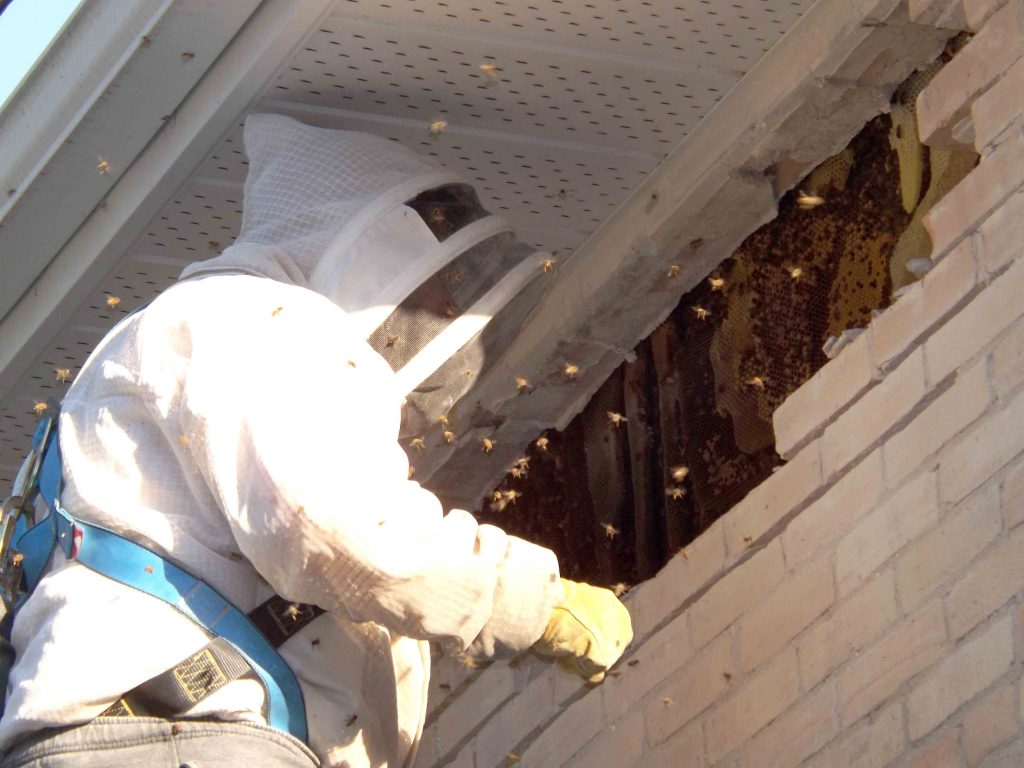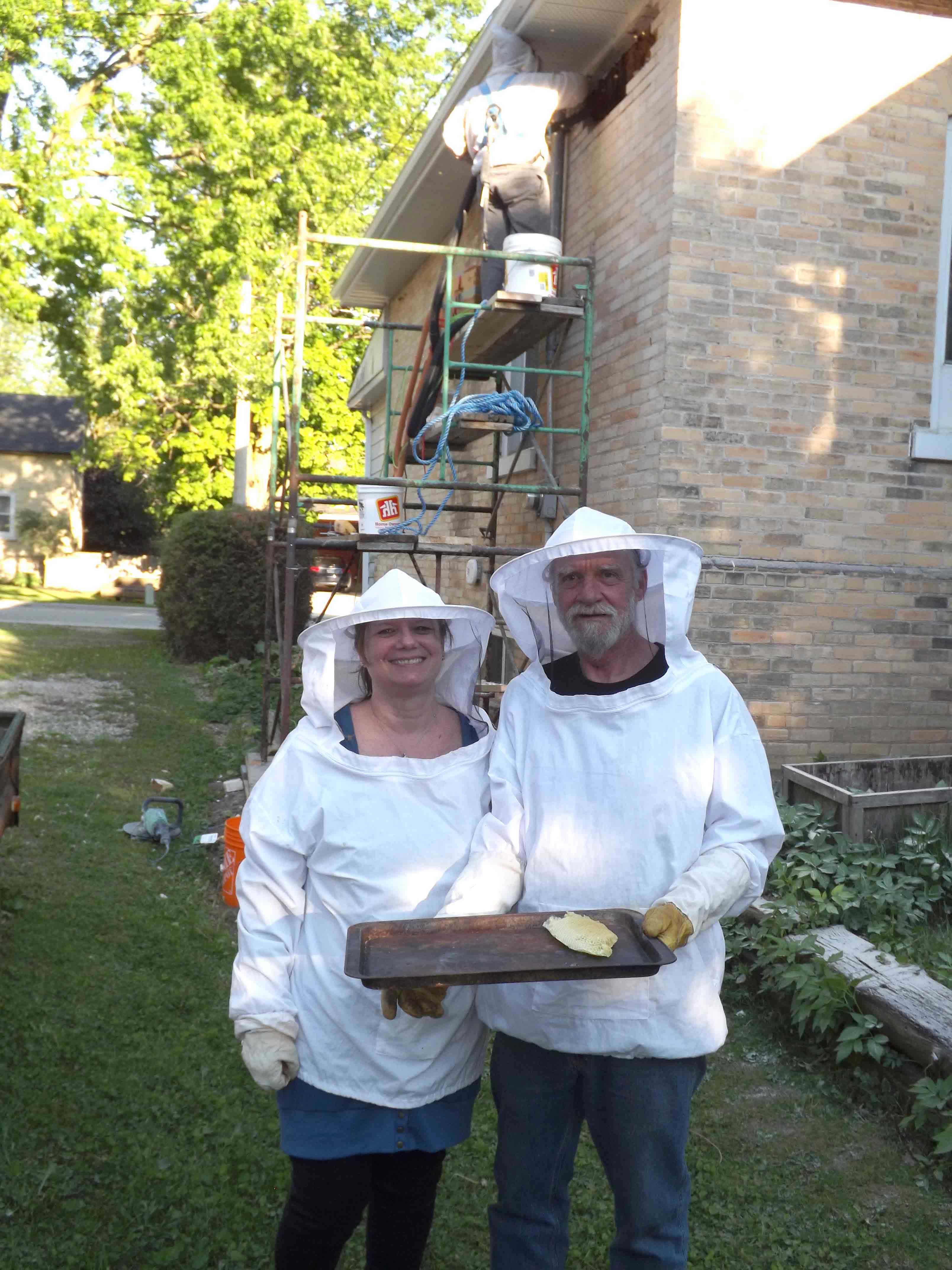HARRISTON – What would you do if you discovered your home contained a massive hive, teeming with tens of thousands of bees?
Start Googling.
That’s what Sandra and Glyn Thomson did when they discovered that honeybees had taken up residence en masse in a space created by a drop ceiling between their attic and kitchen.
“We first noticed them last year when they started showing up in our window … above the sink in the kitchen,” said Sandra. “Every so often we’d grab a glass, put them in a glass and put them back outside. So we did that for a couple of months and then our neighbour next door said, ‘Do you guys realize that you have bees on the side of your house?’”
The Thomsons checked outside to discover a large amount of bees on the wall of their home near the roofline.
“A couple of hundred,” guessed Glyn, who said the neighbours told them they had seen bees covering patches of wall as large as three feet square.
Their initial plan for dealing with the intruders was fairly simple.
“We were hoping last year that when winter came they would go away,” said Sandra.
Glyn filled in the hole with foam in hope of preventing the bees from returning. However this spring, the bees, which had wintered in the attic, dug their way through the foam and made their presence known once again.
The couple went online and found Derek Rice, a beekeeper whose Shelburne-based Royalty Bee Company specializes in bee rescue and extraction.
For Rice, who incorporates the rescued bees into his company’s apiaries, the work is pretty steady, partly due to a limited number of competitors.
“There’s maybe 30 beekeepers that will attempt to do this and maybe four or five in southern Ontario that I know about,” he said.
After confirming the intruders were honeybees – if they were wasps or hornets they could have just sprayed them, noted Glyn – Rice agreed to take on the job.
“Because of dwindling population, you want to save the honeybees,” said Sandra.
Using imaging equipment, Rice determined the hive was about seven feet long, although he couldn’t be sure how wide or deep it was.
“Judging by the activity on the outside of this one … I’m thinking that there’s 50,000-plus bees in there and then when I open it I’m not going to be shocked if I find 80,000,” said Rice on June 2, when he arrived to extract the bees.
“They’ve been a couple of years in there,” Glyn estimated. “We only really noticed them last year.”
Rice uses a special vacuum of his own design, which allows him to control the suction level and avoid injuring the bees.

“One hundred percent of everything that’s in the hive relocates with the bees,” he said. “My survival rate with my bee vacuum is over 99 per cent. It’s really, really good.”
“I can control the flow just enough so it’s sucking up the bees and they go right into a hive,” he added, explaining the vacuum deposits the bees in a bee box, similar to the frames used in apiaries.
The rescued bees are immediately set up in a quarantine apiary and transferred over a period of about six to eight weeks onto normal bee frames.
“As far as jobs go this is a trickier one,” said Rice, who originally planned to go through the attic floor boards to access the hive.
However once he got into the job, he discovered he couldn’t reach the bees through the attic access point and would have to go the more disruptive route of removing bricks from the outside of the Thompson’s home to reach the hive. He postponed the work until June 7.
Although that meant the Thompsons had to live with the pollinators a little longer, Rice said they were in no serious danger unless they proved to be anaphylactic.
“Bees generally won’t swarm you,” he explained. “We have this idea of Africanized honey bees and their instinct is to swarm you … whereas our honey bees are a less aggressive strain.”
He added, “The Africanized honey bees don’t winter here properly, so if they do come in they generally get cut out in the winter.”
Also he noted, “Wasp and hornets, they can sting you multiple times. A honey bee, it only wants to sting you if it really feels it’s protecting the hive to do so. And if it stings you, that’s the end of their life – they lose their life to sting you.”
That said, Rice conceded he gets stung several times during most extractions despite wearing a protective suit and screen mask.
Rice began work on June 7 around noon and finished about midnight, having rescued what he estimated were about 60,000 to 65,000 bees. The hive turned out to be about 6.5 feet long, 10-inches deep and weighed between 70 and 80 pounds.
“It was an incredibly long day and one of the most challenging relocations I have ever done,” said Rice afterward. “The bees have been relocated to my apiary and are already settling in well.”




